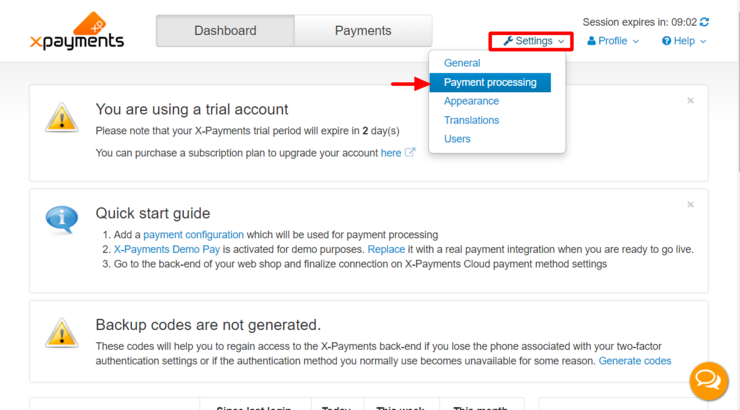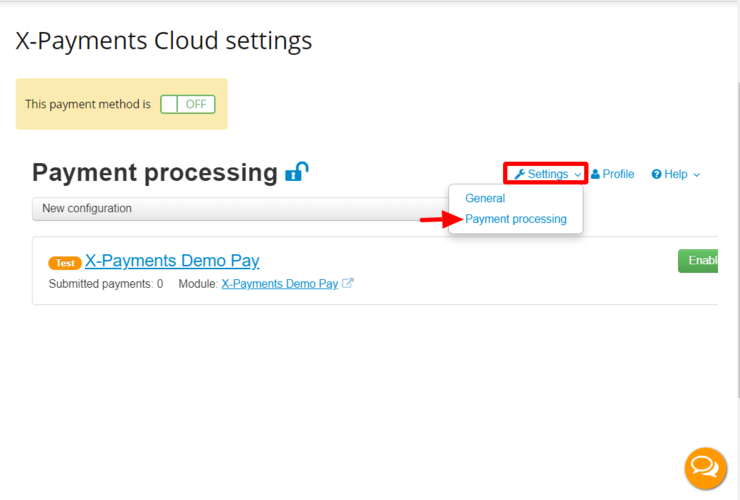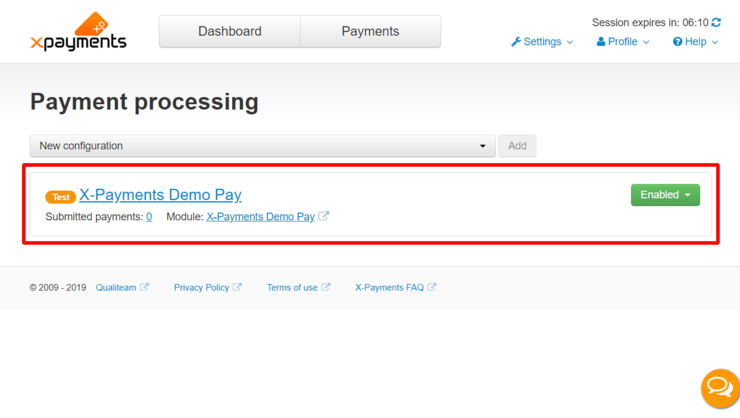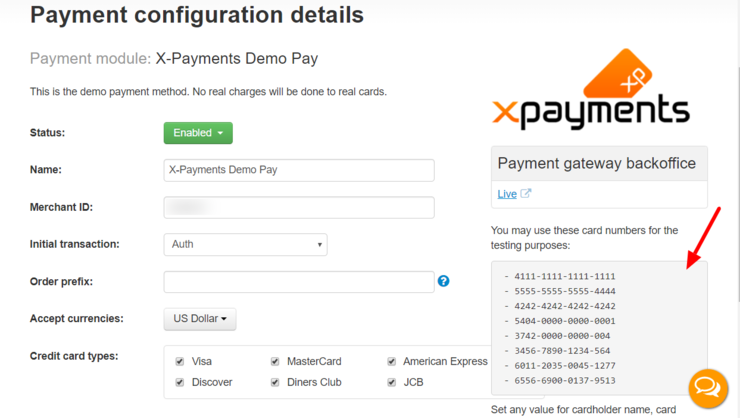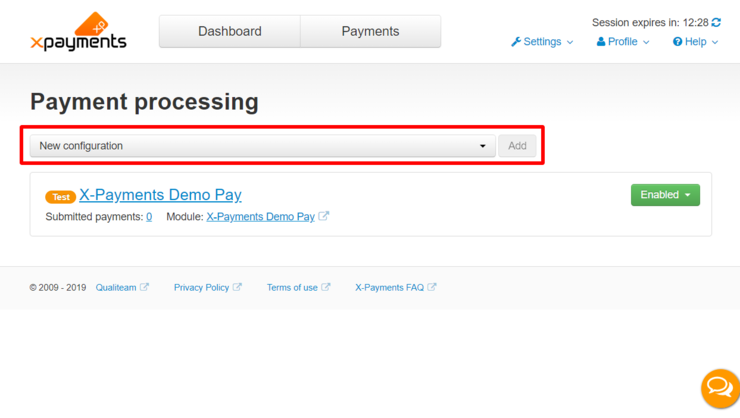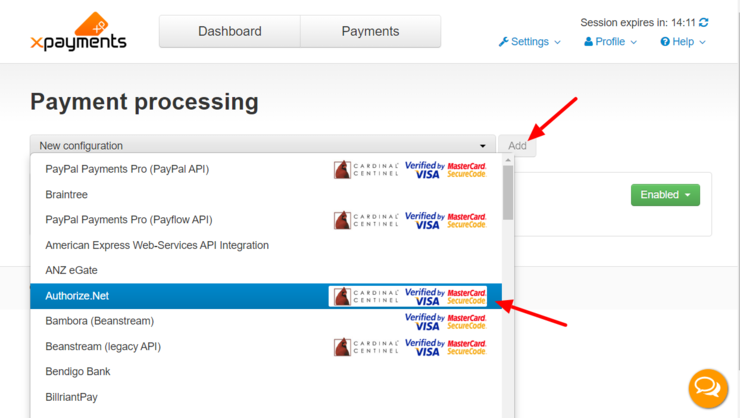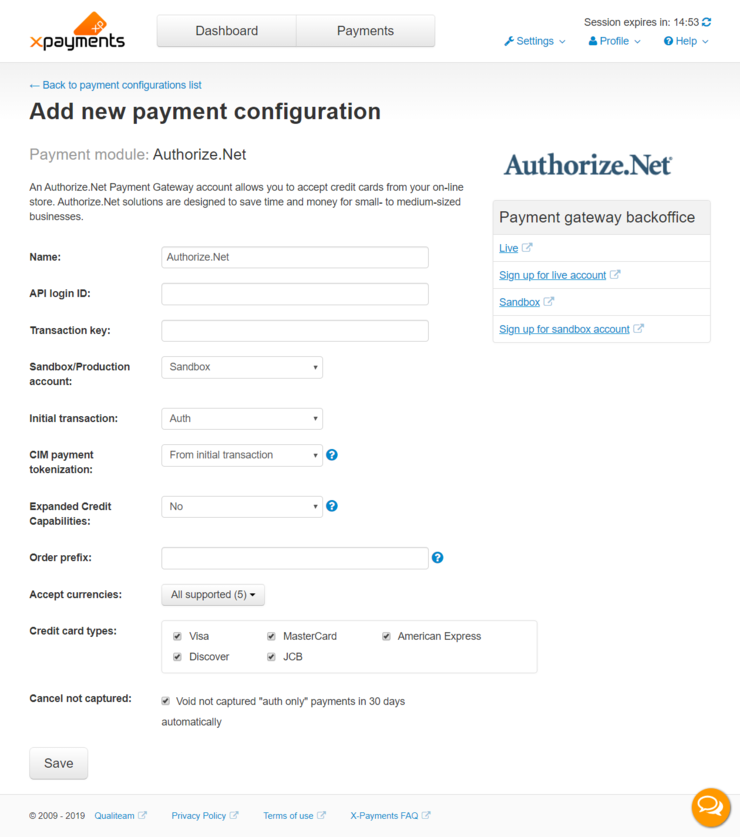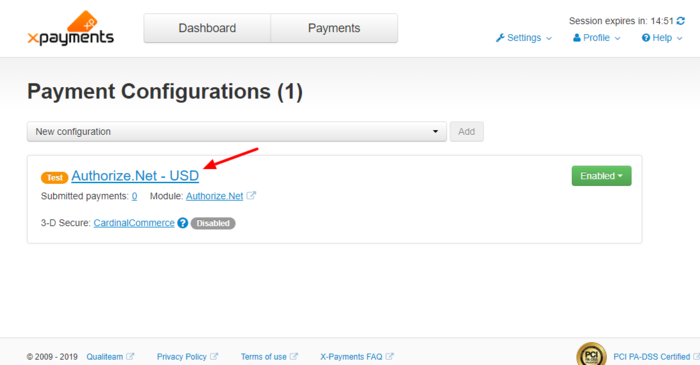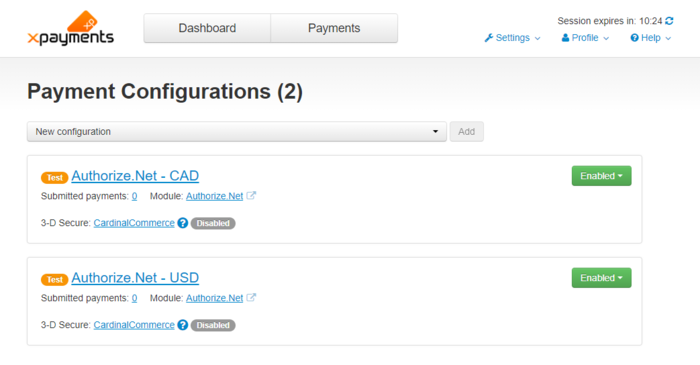XP Cloud:Payment Configurations
- X-Payments Cloud: General information
- Get Started with X-Payments Cloud
- Two-factor User Authentication
- General Settings
- Payment Configurations
- Services
- Users
- User Interface
- Payments
- Payments List
- Payment Statuses
- Search for Payments
- View the Details of a Payment
- Delete a Payment
- Auth and Capture (Capturing Funds)
- Void an Authorization
- Issue a Refund
- Manage High Risk Transactions
- Emulate Transactions
- Clear Cardholder Data
- Tokenization and Re-Use of Saved Cards
- Delayed Payment Feature
- Supported Payment Gateways
- What's New in X-Payments Cloud
An important part of configuring X-Payments Cloud is connecting it to the payment processor that you will use for payments and configuring your payment processing preferences for this connection. We call this creating a payment configuration. If you are going to use more than one payment processor, you will need to create a separate payment configuration for each of them. If you are going to use the same payment processor but with different settings, you will also need to create a separate payment configuration for each case. For example, if you need to be able to accept payments in different currencies, you will need a separate payment configuration for each currency.
In X-Payments Cloud, payment configurations can be created and managed via the Payment processing page (Settings -> Payment processing). This page is available from both the X-Payments Cloud standalone admin panel:
and the X-Payments Cloud admin panel as accessed from within the admin panel of your online store:
Before you can start accepting and processing payments from your online store customers via X-Payments Cloud, you will need to add and enable at least one payment configuration. See Adding a Payment Configuration
Adding a Payment Configuration
New payment configurations can be added via the Payment processing page (Settings -> Payment processing).
In X-Payments Cloud trial, you will find that this page already has one pre-added payment configuration: X-Payments Demo Pay.
The X-Payments Demo Pay payment configuration is purely for testing. You can play with its settings and run some test transactions using the respective payment method in your online store to see how payments via X-Payments Cloud work for your store without having to use your real payment card information. Just be sure to use the demo credit card numbers provided on the payment configuration details page:
To be able to accept real payments, you will need to add a new payment configuration enabling X-Payments Cloud to connect to your chosen payment processor. You can find out whether X-Payments Cloud is integrated with your chosen payment processor here: X-Payments Cloud:Supported Payment Gateways). To add a new payment configuration, select the name of the payment gateway integration you require from the New configuration drop-down box and click Add.
For the sake of example, we will add a payment configuration to accept payments in United States dollar (USD) via Authorize.Net.
We start by selecting the payment gateway integration "Authorize.Net":
Once we click Add, the 'Add new payment configuration' page for Authorize.Net opens:
Here we need to provide the information needed by X-Payments Cloud to access the payment gateway and to specify our payment configuration preferences.
Note that the information we are expected to provide will be different depending on the payment gateway selected. For example, specifically for Authorize.Net, the following details will be needed:
- API Login ID and Transaction key - These values will have to be obtained from Authorize.Net.
- CIM payment tokenization and Expanded Credit Capabilities - These values will have to be set in accordance with our Authorize.Net account settings.
The rest of the fields on the page will be common to most configurations:
- Name: Name to identify the payment configuration in X-Payments Cloud admin panel and the admin panel of your online store. You can keep the proposed name or choose to change it. For example, if you are going to have more than one payment configurations based on the same payment module - like when you want to use more than one currency - it is best to change the name so you can see which payment configuration you are dealing with without having to open its details. For example, we can change the name to "Authorize.Net - USD" to reflect the name of the currency that is going to be used for payments via this configuration.
- Sandbox/Production account or Test/Live mode: Whether you are using a development/sandbox environment or a production environment. A production environment is used for real payments (Live mode), whereas a development/sandbox environment is used for testing (Test mode).
- Initial transaction: The mode in which you want the payment transaction to be conducted when someone buys something at your online store (Auth or Auth and capture).
- Order prefix: Your trading name or any other prefix that will help you to identify a payment transaction as originating from this specific online store.
- Currency: The currency to use for payments.
- Security code required: Whether the buyer should be required to enter a Card Verification Value on the payment page.
- Credit card types: The credit card types you are going to accept.
- Cancel not captured: Whether authorizations obtained for payments made in the "auth only" mode should be voided automatically within 30 days of payment if the capture of the funds has not been performed.
After adjusting the payment configuration settings as you require, be sure to click Save to save your changes.
The payment configuration will be enabled, and you will find a few more settings added on the same page:
- 3-D Secure: What 3-D Secure provider should be used for the payment configuration and the current status of 3-D Secure payer authentication for this payment configuration (Enabled/Disabled).
- Antifraud: What Antifraud service provider should be used for the payment configuration and the current status of Antifraud service for this payment configuration (Enabled/Disabled).
You may adjust them now or at a later time. In any case, you will be able to find and edit the payment configuration you have created via the 'Payment Configurations' section (Settings -> Payment configurations).
More information on payment configurations for the following payment modules is available:
- PayPal: PayPal Payments Pro (PayPal API), PayPal Payments Pro (Payflow API), Payflow Pro
- First Data Payeezy Gateway (ex- Global Gateway e4)
- CyberSource - SOAP toolkit API
Payment Configurations List
Payment configurations that have been added in your X-Payments installation can be viewed and managed on the 'Payment Configurations' page (Settings -> Payment configurations). On this page you can see the list of available payment configurations:
For each payment configuration on the list you can see the name of the payment module employed, the number of submitted payments and the current status of the payment configuration (Enabled or Disabled). Payment configurations set to work in test mode are marked with the "test" icon.
X-Payments 2.1 and later:
- Payment configurations that support 3-D Secure payer authentication are marked as such: the ones that use 3-D Secure via Cardinal Commerce have the link "3D Secure: CardinalCommerce" next to their name (the link leads to a page where 3-D Secure settings for the respective payment configuration can be adjusted); the ones that rely on a 3D Secure solution provided by the payment gateway are marked by the words "3D Secure: Built in". For each payment configuration supporting 3-D Secure transactions there's an icon showing the current status of 3-D Secure payer authentication service (Enabled or Disabled).
- Payment configurations that support KOUNT Antifraud screening are marked as such. The Configure link allows you to access the KOUNT Antifraud screening settings page for the respective payment configuration. For each payment configuration supporting KOUNT there's an icon showing the current status of the antifraud screening service (Enabled or Disabled).
On 'Payment Configurations' page you can:
- Open the details of a specific payment configuration for viewing/editing;
- Enable/disable payment configurations;
- Delete payment configurations;
- X-Payments 2.1 and later: Access the CardinalCommerce 3D-Secure configuration settings page and the KOUNT Antifraud screening settings page for any payment configuration that supports these services.
Viewing the Details of a Payment Configuration
To view the details of a specific payment configuration, click on its name in the 'Payment Configurations' list. The 'Payment configuration details' page opens showing all the information related to the payment configuration.
On this page you can:
- View/edit the details of the payment configuration;
- Enable/disable the payment configuration;
- Delete the payment configuration.
Enabling/Disabling a Payment Configuration
To enable/disable a payment configuration, do one of the following:
- On the 'Payment Configurations' page:
X-Payments 2.0 and later: Click the button dropdown element opposite the payment configuration name and select the required action (Enable / Disable) from the menu: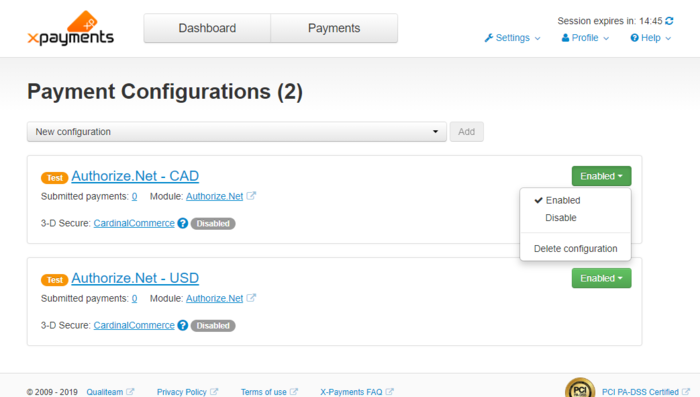
X-Payments 1.0: Click the [ enable ] / [ disable ] link opposite the payment configuration name. - On the 'Payment configuration details' page:
X-Payments 2.0 and later: Click the button dropdown element near the 'Name' field: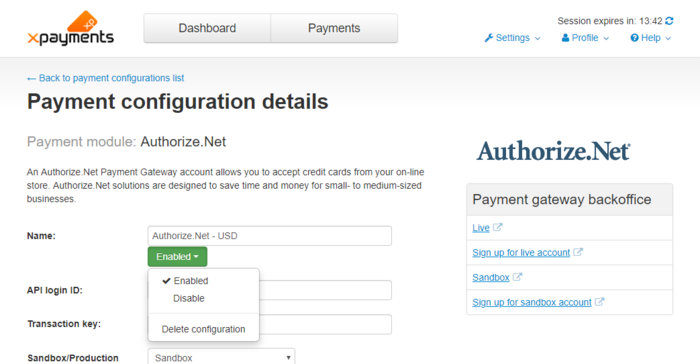
or at the bottom of the page: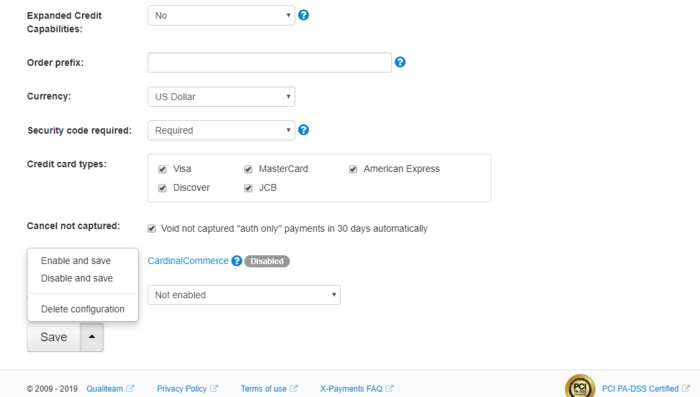
and select the required action (Enable (and save)/Disable (and save)).
X-Payments 1.0: Click the [ enable ] / [ disable ] link below the 'Name' field.
Editing the Details of a Payment Configuration
To edit information about a payment configuration:
- On the 'Payment configuration details' page:
Edit the contents of any editable fields and click Save.
Deleting a Payment Configuration
To delete a payment configuration, do one of the following:
- On the 'Payment Configurations' page:
X-Payments 2.0 and later: Click the button dropdown element opposite the payment configuration name and select the required action (Delete configuration) from the menu. Confirm the deletion.
X-Payments 1.0: Click the delete icon opposite the payment configuration name. Confirm the deletion.
opposite the payment configuration name. Confirm the deletion. - On the 'Payment configuration details' page:
X-Payments 2.0 and later: Click the button dropdown element near the 'Name' field or at the bottom of the page and select the required action (Delete configuration). Confirm the deletion.
X-Payments 1.0: Click the Delete configuration link at the bottom of the page. Confirm the deletion.
